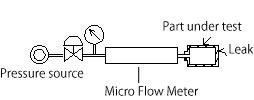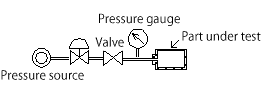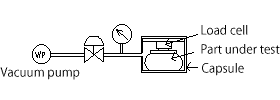Leak testing on production lines—such as for automobiles and gas equipment—has been, up to now, one of the processes causing the most bottleneck.
A method often used in general is to seal air in WORK, submerge it in water, then visually check for bubbles. The cons of this method include that it is impossible to ensure that none are overlooked, a drying process becomes necessary, and it cannot be automated.
Many various testing units have been used in its place, but there were many unsatisfactory aspects, such as with detection sensitivity, pressure resistance, running cost, and in handling.
The differential pressure type air leak tester is the practical application of many improvements as the most effective and practical automatic leak testing unit to replace these conventional methods.
The advantage of using air leak testers
| Automation and work saving | Process can be automated |
|---|---|
| Manpower can be reduced | |
| Easy operation: skill not required | |
| Work environment is improved | |
| Easy maintenance | |
| Quality improvement | Test performance is improved |
| Leak standards can be quantified | |
| Defective rate is reduced | |
| Data can be used in statistical processing and analysis | |
| Cost cutting | Number of claims reduced |
| Yield rate is improved | |
| Drying process is not needed | |
| Test time is reduced | |
| Running cost is low |
1. Cannot be automated×1. Can be automated○
water-dunk test | Evaluation | Air Leak Testers | Evaluation |
|---|---|---|---|
| 2. Operator gets tired | × | 2. Operator does not get tired | ○ |
| 3. Difficult to find leaks behind WORK, etc. | × | 3. Can detect leaks regardless of its location | ○ |
| 4. Detection rate varies by individual | × | 4. No individual variation: technique of operator not necessary | ○ |
| 5. Judgment is subjective and mistakes arise | × | 5. All judgment based on settings, no contrary decisions | ○ |
| 6. Serious leaks could be overlooked | × | 6. Leaks over a certain value are not overlooked | ○ |
| 7. WORK is soiled; rusts. | × | 7. WORK is not soiled; does not rust. | ○ |
| 8. Drying process is necessary. | × | 8. Drying process is not necessary. | ○ |
| 9. Leak location is evident. | ○ | 9. Leak location is not evident. | × |
| 10. No problems for WORK with temperature changes or deformation | ○ | 10. Difficult for WORK with great temperature changes or deformation | × |
| 11. Initial cost is low | ○ | 11. Initial cost is required | × |
| 12. Running cost is required (labor costs) | × | 12. Running cost is low | ○ |
Establishing a quantified leak standard is essential in introducing air leak testers.With this in mind, it is necessary to verify in advance what range of leak is tolerable, by comparing with the conventional water-dunk method or in actual working conditions
It can also be determined based on records of past use or standards of similar WORK.
The leak detection rate of leak testers vary according to the test conditions, such as the test time and the test pressure.
By using several leak-free passing works and a leak reference (Leak Master) and performing some tests under different conditions, the actual value of detection can be known from the data.
When introducing into the production line, care is required, since the temperature of work and the environment and the stability of the clamp seal device all affect the detection rate.
| <※COMMENT> Unit of leak rate | atm·mL/s or atm·mL/min The volume of air leaking into the atmosphere per second or per minute. “atm·” is often omitted. | μgr/s or µg/min The weight of air leaking into the atmosphere per second or per minute. 1 µg (microgram) => 0.83 × 10 − 3 mL (at 1atm, 20°C) | Lusec A leak rate of an increase in pressure of 1 µHg per second in a vacuum chamber of 1 L. 1 Lusec = 1/760 mL/sec ≃ 1.32 × 10 − 3 mL/s l Torr·L/sec A leak rate of an increase in pressure of 1 Torr per second in a vacuum chamber of 1 L. 1 Torr·L/s = 1000 Lusec ≃ 1.32 mL/s | Pa·m3/s 1 Pa·m3/s = 9.869 atm·mL 1 atm·mL/s = 1.013 × 10 − 1 Pa·m3/s | Leak rate describes the volume at atmospheric pressure
|
| (1) Method of detecting bubbles (water-dunk method) Pressured air is sealed inside the part under test. The part is immersed under water or soap water is applied and checked visually for bubbles. |  |
| (2) Method of detecting a different gas (tracer gas method)) A gas which does not exist in the atmospheric air—hydrogen, helium or organic halogen, CFC, or the like—is sealed inside the part under test as a tracer gas, mixed in with pressured air. Any leaked gases inside the airtight chamber surrounding the part under test are detected using a gas detector—a hydrogen leak detector, a helium leak detector, or the like. |  |
| (3) Flow meter method Since the leak rate is equal to the flow rate, the leak rate can be measured by feeding air into the part under test through a micro flow meter. (Applicable products: air flow tester AF-R220) |  |
| (4) Pressure gauge method Positive pressure or vacuum pressure is applied, then the part is sealed. Drop in pressure over time due to leaks is detected by a pressure gauge, pressure sensor, pressure switch, or the like. (Applicable products: digital pressure gauge DP-340BA) |  |
| (5) Differential pressure method Using the same method as (4) but using a differential pressure gauge (U-shaped tube, differential pressure sensor, or the like) in place of the pressure gauge, drop in pressure in the part under test is detected by the difference in pressure compared to the standard tank. This is high in sensitivity, and is the method used in today’s air leak testers. (Applicable products: air leak testers) |  |
| (6) Warping detection method A method using the characteristics of materials which deform easily, such as with vinyl packaging. The part being tested is placed in a capsule and is pulled inside a vacuum, and its warp is detected by a load cell or the like to detect leaks. |  |
×: Bad △: Not so good ○: Good ◎: Very good
| Various leak detection methods | Automation | Detecting capability | Reliability | Durability | Versatility | Economic potential |
|---|---|---|---|---|---|---|
| (1) Method of detecting bubbles | × | ○ | × | ○ | ◎ | △ |
| (2) Method of detecting a different gas (tracer gas method) | ○ | ◎ | ○ | △ | △ | × |
| (3) Flow meter method | ○ | × | ○ | ○ | ○ | ○ |
| (4) Pressure gauge method | ○ | △ | ○ | ◎ | △ | ○ |
| (5) Differential pressure method | ◎ | ○ | ○ | ◎ | ◎ | ○ |
| (6) Warping detection method | ○ | △ | ○ | ○ | × | ○ |


